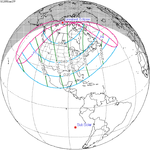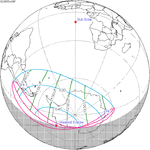Solar eclipse of June 1, 2011
| Solar eclipse of June 1, 2011 | |
|---|---|
 Partial from Tromsø, Norway | |
| Type of eclipse | |
| Nature | Partial |
| Gamma | 1.213 |
| Magnitude | 0.601 |
| Maximum eclipse | |
| Coordinates | 67°48′N 46°48′E / 67.8°N 46.8°E |
| Times (UTC) | |
| (P1) Partial begin | 19:25:17 |
| Greatest eclipse | 21:17:18 |
| (P4) Partial end | 23:06:57 |
| References | |
| Saros | 118 (68 of 72) |
| Catalog # (SE5000) | 9532 |
A partial solar eclipse occurred at the Moon’s descending node of orbit on Wednesday, June 1, 2011,[1][2][3][4][5][6][7][8][9] with a magnitude of 0.601. A solar eclipse occurs when the Moon passes between Earth and the Sun, thereby totally or partly obscuring the image of the Sun for a viewer on Earth. A partial solar eclipse occurs in the polar regions of the Earth when the center of the Moon's shadow misses the Earth.
This eclipse was the second of four partial solar eclipses in 2011, with the others occurring on January 4, July 1, and November 25.
A partial eclipse was visible for parts of Northeast Asia, Alaska, northern Canada, Greenland, northern Scandinavia, and Iceland.
Visibility
[edit]Gallery
[edit]Eclipse season
[edit]This eclipse is part of an eclipse season, a period, roughly every six months, when eclipses occur. Only two (or occasionally three) eclipse seasons occur each year, and each season lasts about 35 days and repeats just short of six months (173 days) later; thus two full eclipse seasons always occur each year. Either two or three eclipses happen each eclipse season. In the sequence below, each eclipse is separated by a fortnight. The first and last eclipse in this sequence is separated by one synodic month.
| June 1 Descending node (new moon) |
June 15 Ascending node (full moon) |
July 1 Descending node (new moon) |
|---|---|---|
 |
 |

|
| Partial solar eclipse Solar Saros 118 |
Total lunar eclipse Lunar Saros 130 |
Partial solar eclipse Solar Saros 156 |
Related eclipses
[edit]Eclipses in 2011
[edit]- A partial solar eclipse on January 4.
- A partial solar eclipse on June 1.
- A total lunar eclipse on June 15.
- A partial solar eclipse on July 1.
- A partial solar eclipse on November 25.
- A total lunar eclipse on December 10.
Metonic
[edit]- Followed by: Solar eclipse of March 20, 2015
Tzolkinex
[edit]- Preceded by: Solar eclipse of April 19, 2004
- Followed by: Solar eclipse of July 13, 2018
Half-Saros
[edit]- Preceded by: Lunar eclipse of May 26, 2002
- Followed by: Lunar eclipse of June 5, 2020
Tritos
[edit]- Preceded by: Solar eclipse of July 1, 2000
- Followed by: Solar eclipse of April 30, 2022
Solar Saros 118
[edit]- Preceded by: Solar eclipse of May 21, 1993
- Followed by: Solar eclipse of June 12, 2029
Inex
[edit]- Preceded by: Solar eclipse of June 21, 1982
- Followed by: Solar eclipse of May 11, 2040
Triad
[edit]- Preceded by: Solar eclipse of July 31, 1924
- Followed by: Solar eclipse of April 1, 2098
Solar eclipses of 2011–2014
[edit]This eclipse is a member of a semester series. An eclipse in a semester series of solar eclipses repeats approximately every 177 days and 4 hours (a semester) at alternating nodes of the Moon's orbit.[10]
The partial solar eclipses on January 4, 2011 and July 1, 2011 occur in the previous lunar year eclipse set.
| Solar eclipse series sets from 2011 to 2014 | ||||||
|---|---|---|---|---|---|---|
| Descending node | Ascending node | |||||
| Saros | Map | Gamma | Saros | Map | Gamma | |
118 Partial in Tromsø, Norway |
June 1, 2011 Partial |
1.21300 | 123 Hinode XRT footage |
November 25, 2011 Partial |
−1.05359 | |
128 Annularity in Red Bluff, CA, USA |
May 20, 2012 Annular |
0.48279 | 133 Totality in Mount Carbine, Queensland, Australia |
November 13, 2012 Total |
−0.37189 | |
138 Annularity in Churchills Head, Australia |
May 10, 2013 Annular |
−0.26937 | 143 Partial in Libreville, Gabon |
November 3, 2013 Hybrid |
0.32715 | |
148 Partial in Adelaide, Australia |
April 29, 2014 Annular (non-central) |
−0.99996 | 153 Partial in Minneapolis, MN, USA |
October 23, 2014 Partial |
1.09078 | |
Saros 118
[edit]This eclipse is a part of Saros series 118, repeating every 18 years, 11 days, and containing 72 events. The series started with a partial solar eclipse on May 24, 803 AD. It contains total eclipses from August 19, 947 AD through October 25, 1650; hybrid eclipses on November 4, 1668 and November 15, 1686; and annular eclipses from November 27, 1704 through April 30, 1957. The series ends at member 72 as a partial eclipse on July 15, 2083. Its eclipses are tabulated in three columns; every third eclipse in the same column is one exeligmos apart, so they all cast shadows over approximately the same parts of the Earth.
The longest duration of totality was produced by member 34 at 6 minutes, 59 seconds on May 16, 1398, and the longest duration of annularity was produced by member 59 at 1 minutes, 58 seconds on February 23, 1849. All eclipses in this series occur at the Moon’s descending node of orbit.[11]
| Series members 57–72 occur between 1801 and 2083: | ||
|---|---|---|
| 57 | 58 | 59 |
 February 1, 1813 |
 February 12, 1831 |
 February 23, 1849 |
| 60 | 61 | 62 |
 March 6, 1867 |
 March 16, 1885 |
 March 29, 1903 |
| 63 | 64 | 65 |
 April 8, 1921 |
 April 19, 1939 |
 April 30, 1957 |
| 66 | 67 | 68 |
 May 11, 1975 |
 May 21, 1993 |
 June 1, 2011 |
| 69 | 70 | 71 |
 June 12, 2029 |
 June 23, 2047 |
 July 3, 2065 |
| 72 | ||
 July 15, 2083 | ||
Metonic series
[edit]The metonic series repeats eclipses every 19 years (6939.69 days), lasting about 5 cycles. Eclipses occur in nearly the same calendar date. In addition, the octon subseries repeats 1/5 of that or every 3.8 years (1387.94 days). All eclipses in this table occur at the Moon's descending node.
| 22 eclipse events between June 1, 2011 and October 24, 2098 | ||||
|---|---|---|---|---|
| May 31–June 1 | March 19–20 | January 5–6 | October 24–25 | August 12–13 |
| 118 | 120 | 122 | 124 | 126 |
 June 1, 2011 |
 March 20, 2015 |
 January 6, 2019 |
 October 25, 2022 |
 August 12, 2026 |
| 128 | 130 | 132 | 134 | 136 |
 June 1, 2030 |
 March 20, 2034 |
 January 5, 2038 |
 October 25, 2041 |
 August 12, 2045 |
| 138 | 140 | 142 | 144 | 146 |
 May 31, 2049 |
 March 20, 2053 |
 January 5, 2057 |
 October 24, 2060 |
 August 12, 2064 |
| 148 | 150 | 152 | 154 | 156 |
 May 31, 2068 |
 March 19, 2072 |
 January 6, 2076 |
 October 24, 2079 |
 August 13, 2083 |
| 158 | 160 | 162 | 164 | |
 June 1, 2087 |
 October 24, 2098 | |||
Tritos series
[edit]This eclipse is a part of a tritos cycle, repeating at alternating nodes every 135 synodic months (≈ 3986.63 days, or 11 years minus 1 month). Their appearance and longitude are irregular due to a lack of synchronization with the anomalistic month (period of perigee), but groupings of 3 tritos cycles (≈ 33 years minus 3 months) come close (≈ 434.044 anomalistic months), so eclipses are similar in these groupings.
The partial solar eclipses on April 8, 1902 (part of Saros 108) and January 5, 1935 (part of Saros 111) are also a part of this series but are not included in the table below.
| Series members between 2000 and 2200 | ||||
|---|---|---|---|---|
 July 1, 2000 (Saros 117) |
 June 1, 2011 (Saros 118) |
 April 30, 2022 (Saros 119) |
 March 30, 2033 (Saros 120) |
 February 28, 2044 (Saros 121) |
 January 27, 2055 (Saros 122) |
 December 27, 2065 (Saros 123) |
 November 26, 2076 (Saros 124) |
 October 26, 2087 (Saros 125) |
 September 25, 2098 (Saros 126) |
 August 26, 2109 (Saros 127) |
 July 25, 2120 (Saros 128) |
 June 25, 2131 (Saros 129) |
 May 25, 2142 (Saros 130) |
 April 23, 2153 (Saros 131) |
 March 23, 2164 (Saros 132) |
 February 21, 2175 (Saros 133) |
 January 20, 2186 (Saros 134) |
 December 19, 2196 (Saros 135) | |
Inex series
[edit]This eclipse is a part of the long period inex cycle, repeating at alternating nodes, every 358 synodic months (≈ 10,571.95 days, or 29 years minus 20 days). Their appearance and longitude are irregular due to a lack of synchronization with the anomalistic month (period of perigee). However, groupings of 3 inex cycles (≈ 87 years minus 2 months) comes close (≈ 1,151.02 anomalistic months), so eclipses are similar in these groupings.
| Series members between 1801 and 2200 | ||
|---|---|---|
 October 19, 1808 (Saros 111) |
||
 August 20, 1895 (Saros 114) |
 July 31, 1924 (Saros 115) |
 July 11, 1953 (Saros 116) |
 June 21, 1982 (Saros 117) |
 June 1, 2011 (Saros 118) |
 May 11, 2040 (Saros 119) |
 April 21, 2069 (Saros 120) |
 April 1, 2098 (Saros 121) |
 March 13, 2127 (Saros 122) |
 February 21, 2156 (Saros 123) |
 January 31, 2185 (Saros 124) |
|
Notes
[edit]References
[edit]- ^ "June 1, 2011 Partial Solar Eclipse". timeanddate. Retrieved 11 August 2024.
- ^ Malik, Tariq (2011-06-02). "Rare 'Midnight' Partial Solar Eclipse Amazes Northern Skywatchers". Space.com.
- ^ Peralta, Eyder (2011-06-03). "Stunning: A Solar Eclipse At Midnight". NPR.
- ^ Fazekas, Andrew (2011-06-02). "Solar Eclipse at Midnight? Sun Smiles on Arctic Tonight". National Geographic. Archived from the original on March 3, 2021.
- ^ Grossman, Lisa (2011-06-03). "Rare Midnight Solar Eclipse Caught in Arctic" – via Wired.
- ^ "Looking skyward". News-Journal. Mansfield, Ohio. 2011-06-01. p. 2. Retrieved 2023-10-18 – via Newspapers.com.
- ^ "Skywatch data". The Bangor Daily News. Bangor, Maine. 2011-06-01. p. 14. Retrieved 2023-10-18 – via Newspapers.com.
- ^ "Weather Report". Poughkeepsie Journal. Poughkeepsie, New York. 2011-06-01. p. 10. Retrieved 2023-10-18 – via Newspapers.com.
- ^ "Plenty to see even with shorter nights". Kent County News. Chestertown, Maryland. 2011-06-02. p. 7. Retrieved 2023-10-18 – via Newspapers.com.
- ^ van Gent, R.H. "Solar- and Lunar-Eclipse Predictions from Antiquity to the Present". A Catalogue of Eclipse Cycles. Utrecht University. Retrieved 6 October 2018.
- ^ "NASA - Catalog of Solar Eclipses of Saros 118". eclipse.gsfc.nasa.gov.
External links
[edit]- Shadow and Substance: Partial Eclipse of the Sun June 1, 2011 Archived December 8, 2011, at the Wayback Machine
- Midnight's Solar Eclipse APOD 2011/6/3
- SpaceWeather Gallery for partial solar eclipse of June 1, 2011
- Report about the partial eclipse in Bratsk, Russia (in Russian)






